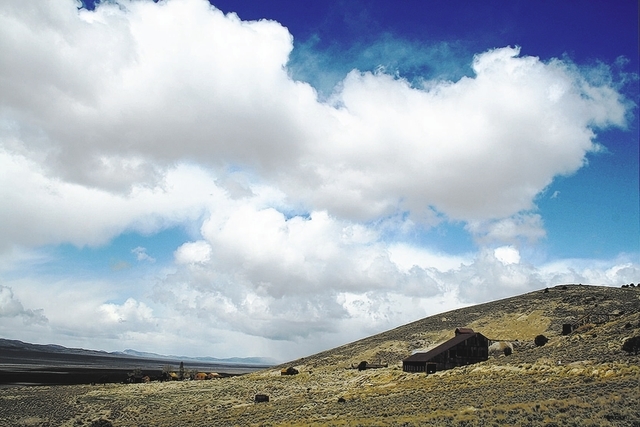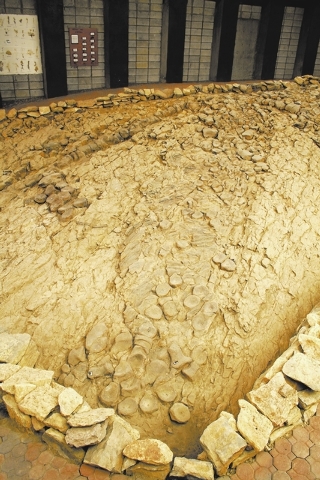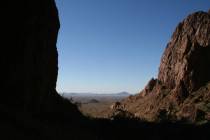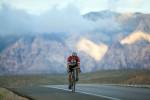Berlin-Ichthyosaur State Park in a class of its own
Nevada is home to 23 state parks, the majority with only one unique feature. But Berlin-Ichthyosaur State Park is in a class of its own, as it features not only a well-preserved historic mining town but also remains of the ancient ichthyosaur (pronounced ICK-thee-o-saur), our state fossil.
It lies a couple of hours’ drive north of Tonopah on the western edge of the Shoshone mountain range, a remote place that most people would describe as the middle of nowhere. Even so, it’s worth visiting at least once in your travels. And summer is the logical time to do it, as elevations in the 1,540-acre park range from 6,840 to 7,880 feet, offering agreeably cool temperatures in summer. Late fall brings bitter cold, and road conditions sometimes make winter visits impossible.
On arriving, you will be in the Berlin Townsite area. In 1863, prospectors discovered the Union Ledge, the first major ore body in this area. With other good finds, the area was organized as the Union Mining District, and the Berlin Mine was added in 1896. All was well at this camp until 1908, when labor disputes and low yields took their toll. By 1911, Berlin was but a ghost town.
The best way to enjoy the townsite is on foot, taking a self-guided tour of more than 70 historic sites and buildings. They are identified by interpretive plaques along well-worn trails. The most prominent structure is the Berlin Mill. If you peek inside the building, you will see the remains of a bank of stamps, separating tables and other artifacts. The mill once housed 30 stamps, a crusher, four steam engines and five boilers.
After you tour Berlin, head up the gravel road about 1.7 miles, and you will arrive at the covered quarry site of the ichthyosaurs. Along the way, you will come to the town site of Union, which once boasted a school, a town hall, a mill, a saloon and many homes. Much of this town has vanished into ruins, though there is a short interpretive trail with plaques.
Continue up the road to the shelter site of the ichthyosaur fossils, signed and on your right. The fossils were discovered in 1928 by a professor from Stanford University, yet excavation work wasn’t begun until 1954. Ichthyosaur fossils have been found on every continent but Antarctica. The ones there, reaching 50 feet in length, are some of the largest specimens in the world.
Ichthyosaurs were ancient marine vertebrates that lived in the ocean that covered central Nevada more than 200 million years ago. The site contains the remains of nine different ichthyosaurs, and many segments are visible. Some of the fossils are skulls, jaws, backbones, flipper bones, tailbones and even a well-preserved ribcage.
Summer tours of the fossil shelter run about 40 minutes and are available at 10 a.m. and 2 p.m. daily through Labor Day, with a noon tour added on Saturdays and Sundays. If you can’t take a tour, there are viewing windows. Tours of the nearby Diana Mine run at 11 a.m. and 1 p.m. Fridays, Saturdays and Sundays; these require reservations.
If you plan to stay in the area, camping is the best choice, as lodging is a couple of hours away. There are 14 roomy sites, great for tents and some that can accommodate RVs up to 25 feet long. Sites have barbecue grills and fire pits, covered tables and, from mid-April to October, drinking water. With our dry conditions in the West, it is always advisable to call ahead about possible fire restrictions. For reservations or information, call 775-964-2440 or visit the website, parks.nv.gov/parks/bi.
Directions
From Las Vegas, take U.S. Highway 95 north for about 287 miles, passing through Tonopah. Go right onto Nevada state Route 361 and follow for about 28 miles to Gabbs. Take a right onto Nevada state Route 844 and drive about 16 miles to the park.
Deborah Wall is the author of “Great Hikes, A Cerca Country Guide” and “Base Camp Las Vegas: Hiking the Southwestern States,” published by Stephens Press. She can be reached at deborabus@aol.com.
Directions
From Las Vegas, it is about 285 miles to the trailhead. Take Interstate 15 north 125 miles into Utah and take the Hurricane/Zion National Park exit. Follow state Route 9 for 57 miles through Zion National Park, and turn left onto U.S. Highway 89 north. Take Utah state Route 89 for 44 miles to a right onto Utah state Route 12. Follow that for 60 miles to the town of Escalante. Drive east on state Route 12 for 5 more miles, then turn right onto the well-marked Hole-in-the-Rock Road. Follow this gravel road for about 26 miles, and go left on Dry Fork Road, staying left at the fork and follow about 1 ½ miles to trailhead.





























